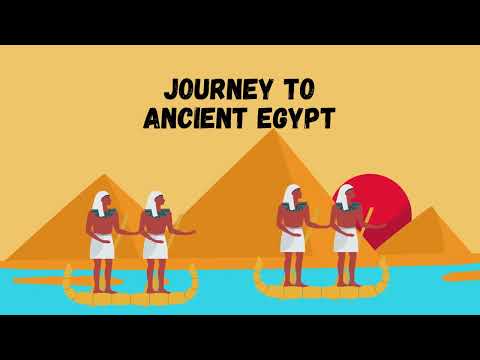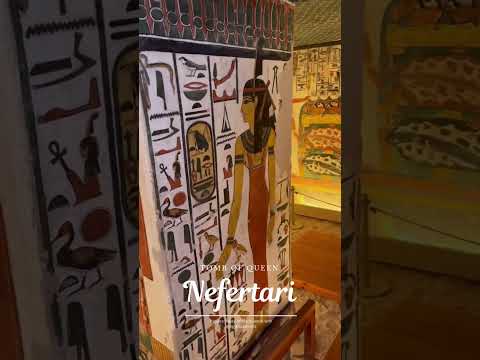Exploring Ancient Egypt is essential to understanding the world’s history and the development of human civilization. Imagine stepping back in time. You find yourself in a world where the Great Pyramids of Giza touch the sky, which were constructed as tombs for Egyptian Pharaohs and their consorts. The mighty Nile River supports a thriving civilization. And the enigmatic hieroglyphs tell stories of divine pharaohs.
In addition to the pyramids, there are many other Egypt Temples, tombs, and ancient ruins to explore. The Karnak Temple complex in Luxor, for example, is one of the largest ancient religious sites in the world and features stunning examples of Egyptian art and architecture. The Valley of the Kings, located on the west bank of the Nile, is another must-visit site for anyone interested in Ancient Egypt, as it contains the tombs of many Pharaohs, including the famous Tutankhamun.
This is the allure of ancient Egypt. It has captivated explorers, historians, and adventurers. Get ready for an unforgettable journey through this ancient land. The secrets of the past await your discovery.
Unearth the mysteries of the past with our Ancient Egypt Tours. Don’t miss this opportunity. Reserve your historical journey today!
Key Takeaways
- Uncover the origins and rise of the Nile Valley civilization, which flourished for over 5,970 years.
- Delve into the world of the powerful pharaohs, who were revered as divine rulers of ancient Egypt.
- Marvel at the architectural marvels of the Pyramids of Giza and the enigmatic Sphinx.
- Decipher the mysteries of ancient Egyptian hieroglyphs and their written legacy.
- Explore all about clothing in ancient Egypt and fashion
- Explore the rich mythology and beliefs that shaped the cultural landscape of this ancient civilization.
Take advantage of our discounted offers with the following All-Inclusive Vacations to Egypt
- 7-Day Cairo with Nile Cruise Tour Package Get -100 USD
- 8 Days Cairo with 3 Nights Nile Cruise by Flight Get 10% Off + Free Activities
- 8 Days Cairo and Nile Cruise Holidays with Abu Simbel Get 7% OFF
- 10-Day Cairo, Alexandria, and Nile Cruise with Abu Simbel by Flight Get 10% OFF
- 12-Day Cairo City & Nile Cruise and Hurghada City
Introduction to Exploring Ancient Egypt
Start an exciting journey through ancient Egypt’s long history. Here, the old and new worlds meet, full of wonder and mystery. See the towering pyramids and mysterious hieroglyphs that tell of an ancient culture.
The story of ancient Egypt begins in the Predynastic Period, lasting over 2,000 years. People moved from hunting to farming, leading to big steps in art and crafts. Around 3400 B.C., two kingdoms formed – the Red Land and the White Land. They merged under King Menes, starting the first dynasty, around 3100 B.C.
The Archaic Period (3100-2686 B.C.) saw Egyptian society grow and kingship become a big deal. This led to the Old Kingdom (2686-2181 B.C.), famous for its pyramids. The Great Pyramid of Giza was built in just 20 years for Pharaoh Khufu.
“The Great Pyramid of Khufu, built in 2530 BC, took 20 years to complete and stands as a testament to the engineering prowess of ancient Egyptian civilization.”
After the Old Kingdom fell, the Middle Kingdom rose, followed by the Hyksos. Ancient Egypt’s history is full of ups and downs. The New Kingdom (1567-1085 B.C.) was a time of unity and empire, with leaders like Queen Hatshepsut and Akhenaton.
You can discover Egyptian culture by checking out: Egypt Culture Tours
|
Period |
Dates |
Key Events |
|
Predynastic Period |
Lasted at least 2,000 years |
Transition from hunting to agriculture, setting the stage for advancements in arts and crafts |
|
Archaic Period |
3100-2686 B.C. |
Growth of Egyptian society and the concept of kingship |
|
Old Kingdom |
2686-2181 B.C. |
Construction of the Great Pyramid at Giza for Khufu, built by an estimated 100,000 men in 20 years |
|
New Kingdom |
1567-1085 B.C. |
Reunification of Egypt and establishment of a vast empire, with notable figures such as Queen Hatshepsut and Akhenaton |
Exploring ancient Egypt takes us to a place where gods and humans lived together. It’s a world where people sought to live forever. Come with us to discover the secrets of the past and see the lasting impact of this remarkable civilization.
The Ancient Egyptian Civilization: A Timeless Wonder
The ancient Egyptian civilization started around 3100 BCE. It grew along the Nile River. This culture was one of the oldest in the world.
It brought together Upper Egypt and Lower Egypt. The pharaohs, seen as gods, ruled everything. They controlled the government, military, and religion.
Origins and Rise of the Nile Valley Civilization
The Nile Valley was where ancient Egypt thrived. It was fertile and gave the Egyptians what they needed to live and grow. The Nile’s annual flood helped them farm and build homes.
As time went on, the pharaohs became very powerful. They built huge temples, tombs, and monuments. This showed their wealth and connection to the gods.
Uniting Upper and Lower Egypt under the Pharaohs
The pharaohs were chosen by the gods. They played a big role in uniting ancient Egyptian civilization. They brought together Upper and Lower Egypt, creating a strong state.
Their power was shown in buildings like the Pyramids of Giza and the Temple of Karnak. These structures showed their wealth, influence, and divine connection.
|
Key Facts about the Nile Valley Civilization |
Statistics |
|
Duration of the Old Kingdom |
Approximately 2686 BCE to 2181 BCE |
|
Height of the Great Pyramid of Giza |
Originally 146 meters (481 feet) |
|
Size of the Karnak Temple Complex |
Approximately 100 hectares |
“The Nile River was the lifeblood of ancient Egyptian civilization, providing the necessary resources for its flourishing and growth.”
The Pyramids of Giza: Architectural Marvels
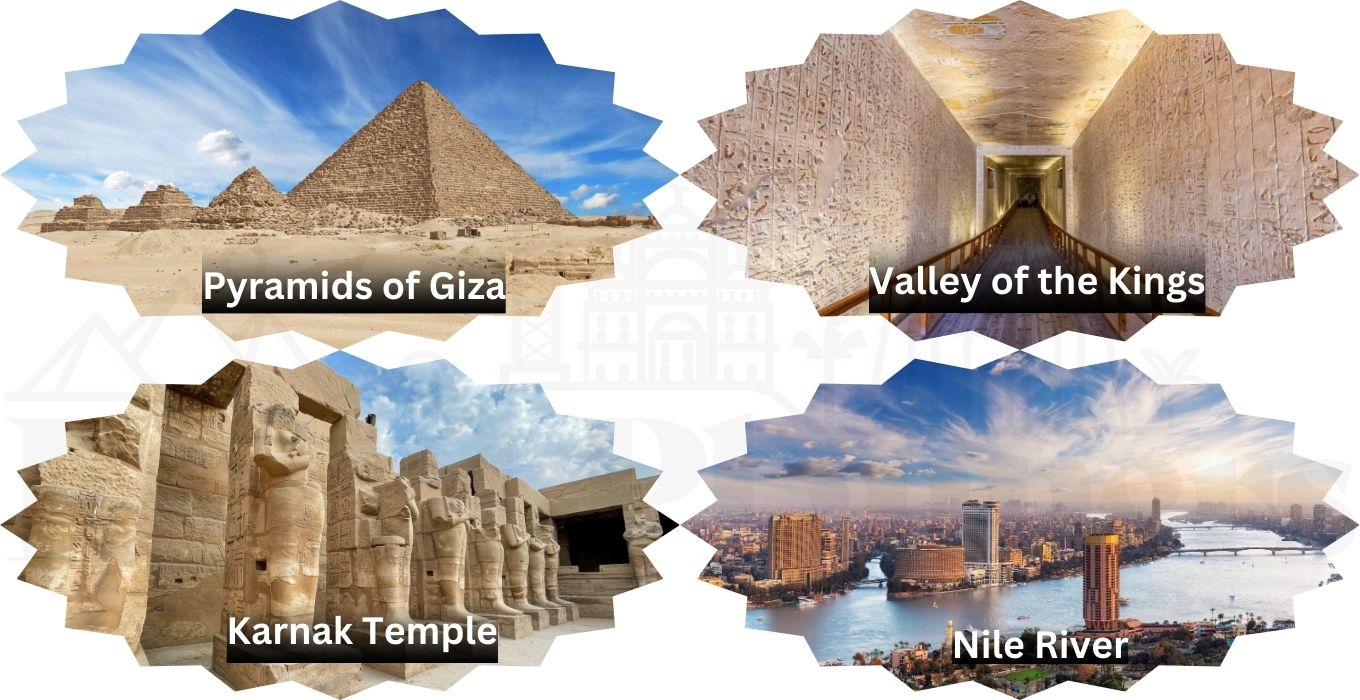
The pyramids of Giza stand tall in the Saharan desert. They show the skill and greatness of ancient Egypt. These huge structures were built as tombs for pharaohs.
They have amazed explorers, historians, and travelers for a long time.
The Great Pyramid: Tomb of Khufu
The Great Pyramid is the top wonder of Giza. It was built for Pharaoh Khufu around 2560 BCE. It’s huge, with each side 755 feet long and originally 482 feet tall.
It’s made of 2.3 million stone blocks, weighing 5.75 million tons. Even after all these years, it shows the amazing skills of its builders. Its sides are perfectly aligned with the cardinal points.
Unraveling the Mysteries of the Sphinx
The Great Sphinx stands watch on the Giza plateau. It’s a giant statue with a lion’s body and a human head. It’s thought to be of Pharaoh Khafre, who built the second-largest pyramid at Giza.
But what it really means and why it was built is still a mystery. This makes the Sphinx even more fascinating and mysterious.
|
Attraction |
Dimensions |
Construction Period |
Significance |
|
The Great Pyramid of Giza |
755 feet (230 meters) on each side, originally 482 feet (147 meters) tall |
Around 2560 BCE, during the reign of Pharaoh Khufu |
Largest and most famous of the Giza pyramids, a testament to ancient Egyptian engineering |
|
The Great Sphinx |
Statue with a lion’s body and a human head |
Believed to have been constructed during the reign of Pharaoh Khafre |
Enigmatic and captivating landmark, its true purpose and symbolism still debated by researchers |
Karnak and Luxor Temples: Monumental Wonders
The Karnak and Luxor Temples sit by the Nile River in Luxor. They show the skill and design of ancient Egypt. For years, they have amazed people, showing the greatness and spiritual beliefs of this old civilization.
The Karnak Temple Complex is huge, covering over 200 acres. It has a history of more than 2,000 years. It was a key place for religion and politics, with the Great Hypostyle Hall having 134 big columns. The carvings and hieroglyphs on these columns tell us about the ancient Egyptians’ beliefs.
Luxor Temple was built by Amenhotep III and later grown by Ramses II around 1400 BC. Who in turn built the Abu Simbel Temple in Aswan. There’s also a chapel for Alexander the Great, showing the lasting impact of this old civilization.
These two temples remind us of the ancient Egyptians’ skill and design. From Karnak’s big columns to Luxor’s detailed carvings, these monumental wonders still amaze and inspire everyone who sees them.
|
Karnak Temple |
Luxor Temple |
|
|
The Karnak and Luxor Temples show the lasting impact of ancient Egyptian architecture. They show deep respect for the gods and pharaohs of this amazing civilization. These monumental wonders still amaze and inspire all who see them.
Valley of the Kings: Royal Burial Site
Valley of the Kings is in the western Theban Necropolis. It shows the grandeur of ancient Egyptian pharaohs. The tombs are filled with amazing paintings and hieroglyphs.
The Valley of the Kings was where most pharaohs of the 18th, 19th, and 20th dynasties were buried. It was chosen to keep their tombs safe and hidden.
Visiting the Valley of the Kings lets you see the legacy of these rulers. There are over 62 tombs, each with its own story. It’s a window into ancient Egyptian life.
Some famous tombs include:
- The tomb of Queen Hatshepsut, which goes 320 feet down and is 700 feet from the entrance.
- The largest tomb, KV5, for many sons of Ramses II.
- The tomb of Ramses VIII, still a secret.
The Valley of the Kings is a UNESCO World Heritage site. It’s part of ancient Thebes, along with Luxor, the Valley of the Queens, and Karnak.
“Exploring the tombs in the Valley of the Kings provides a unique opportunity to connect with the legacy of these divine rulers and the civilization they presided over.”
Whether you love history or just want to see something new, the Valley of the Kings is a must-see. It shows the world of ancient Egyptian pharaohs and their royal burial site.
The Nile River: Lifeline of Ancient Egypt
The ancient Egyptian civilization thrived along the Nile River. This fertile valley gave them the resources they needed to grow. The Nile, stretching 4,160 miles, was their lifeblood, offering water, food, and a way to travel.
Without the Nile, the Egyptians wouldn’t have built their famous monuments. They also wouldn’t have had the food and water to live. The Nile’s flooding made the land fertile, letting farmers grow crops like wheat and barley.
The Egyptians created advanced irrigation systems to use the Nile’s water for farming. This made the Nile Valley (Kemet) and the desert (Deshret) distinct.
The Nile was more than just for farming. It was also a key part of trade and commerce. Art shows boats carrying goods like cattle and vegetables. Even in the afterlife, the Egyptians believed in the Nile’s importance, burying their kings with boats.
|
Nile River Facts |
Details |
|
Length |
4,160 miles (6,650 km) |
|
Irrigation Systems |
Basin irrigation to maximize Nile’s waters for farming |
|
Nile’s Influence |
Shaped division of Egypt into Kemet (Nile Valley) and Deshret (desert) |
|
Nile’s Role |
Transportation of goods, burial of kings and dignitaries with boats |
In modern times, the Nile is still crucial for Egypt. Aswan High Dam controls flooding and provides power. Lake Nasser, a huge artificial lake, is a tourist spot. Luxor, along the Nile, is called the “World’s Greatest Open-Air Museum.”
The Nile’s role in ancient Egypt and today shows its lasting impact. It’s a symbol of Egypt’s power and resilience.
Egyptian Pharaohs: Divine Rulers of Ancient Egypt
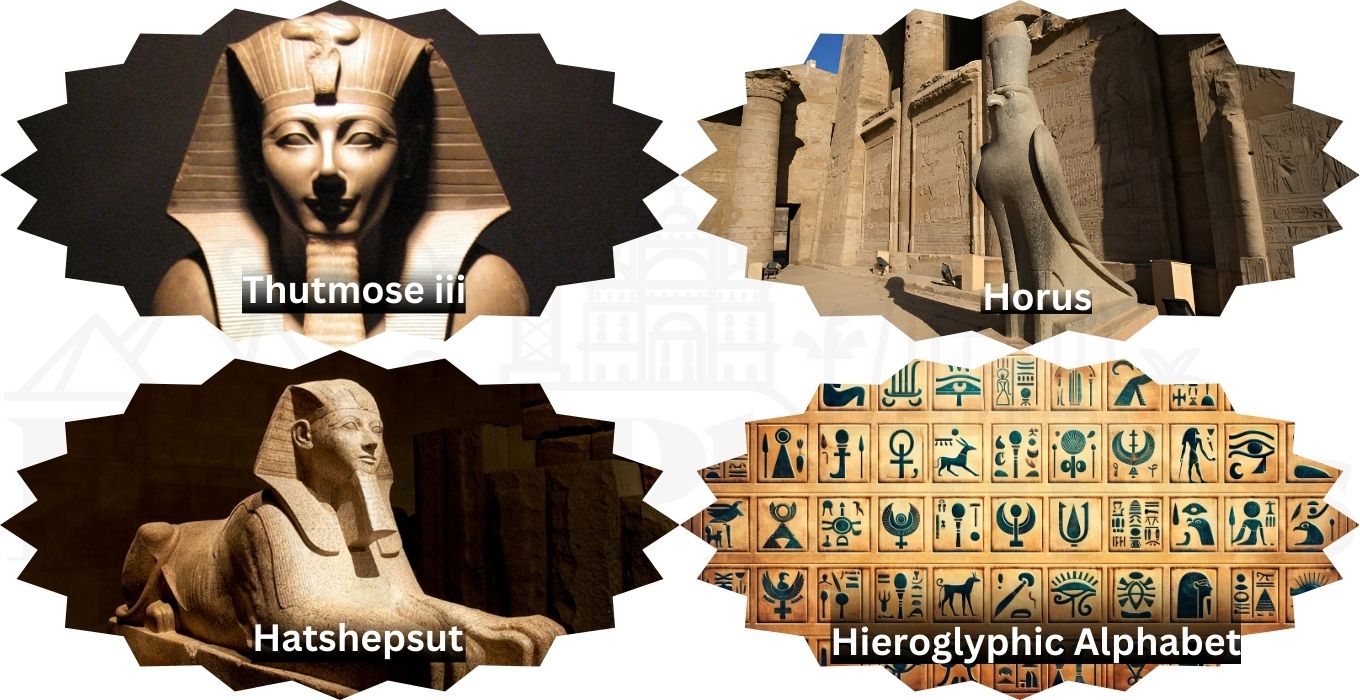
The pharaohs of ancient Egypt were seen as gods on earth. The gods and goddesses chose them to lead their people. These rulers had total power over the government, military, and religion of the Nile Valley.
They built famous monuments like pyramids, temples, and tombs. These structures amazed the world and still do today.
Some famous pharaohs include:
- Khufu, who built the Great Pyramid of Giza from 2589 to 2566 BCE.
- Hatshepsut one of the most powerful Egyptian queens, ruled from 1478 to 1458 BCE. She expanded trade and built many projects like the Hatshepsut temple.
- Akhenaten, who ruled from 1353 to 1336 BCE, started a new religion focused on the sun god Aten.
- Tutankhamun, who ruled from 1332 to 1323 BCE, is famous for his tomb found in 1922. It showed how ancient Egyptians buried their dead.
- Ramses II, who ruled from 1279 to 1213 BCE, built big temples, expanded Egypt, and was linked to the Exodus in the Bible.
The pharaohs’ rule ended with the Roman conquest of Egypt in 30 BCE. This made Egypt a Roman province, ending the pharaohs’ divine rule.
|
Pharaoh |
Reign |
Significant Achievements |
|
Khufu |
2589 – 2566 BCE |
Construction of the Great Pyramid of Giza |
|
Hatshepsut |
1478 – 1458 BCE |
Expanding trade networks and initiating building projects |
|
Akhenaten |
1353 – 1336 BCE |
Religious revolution focused on the worship of the sun god Aten |
|
Tutankhamun |
1332 – 1323 BCE |
Valuable insights into ancient Egyptian burial practices |
|
Ramses II |
1279 – 1213 BCE |
Construction of monumental temples, expansion of borders, identified as the pharaoh of the Exodus |
The pharaohs of ancient Egypt left a lasting impact on history. They shaped the culture, religion, and architecture of the Nile Valley. Their divine status and power still fascinate scholars and the public today, encouraging more study and understanding of this mysterious time.
Egyptian Hieroglyphic Alphabet: The Written Legacy
Hieroglyphic writing was key to ancient Egypt, lasting over 5,000 years until the 4th century A.D. It was a system of pictures that told their stories, history, and daily life. Unraveling The Symbols of the Egyptian hieroglyphic alphabet has been a long journey for scholars.
The Egyptians had different writing styles, like hieroglyphic, hieratic, and demotic. Hieroglyphics were for big monuments, while hieratic and demotic were quicker. Over time, the number of symbols went from over a thousand to about 750.
Decoding the Ancient Egyptian Script
The Rosetta Stone’s discovery in 1799 was a big step in understanding hieroglyphs. Scholars like Thomas Young and Jean-François Champollion worked together to crack the code. They found that hieroglyphs were a mix of symbols, sounds, and meanings.
Even with this progress, reading hieroglyphs is still tricky. It needs guesswork and knowledge of ancient Egyptian culture. As we learn more, we understand the ancient Egyptians better.
|
Key Facts about Egyptian Hieroglyphs |
Details |
|
Period of Use |
Approximately 3200 BCE to 4th century CE |
|
Number of Hieroglyphs |
Over 1,000 initially, reduced to around 750 during the Middle Kingdom |
|
Writing Materials |
Papyrus, wood, ceramic, metal, stone, clay tablets, bone, and leather |
|
Decipherment |
Breakthrough in the early 19th century with the work of Jean-François Champollion and the Rosetta Stone |
|
Decline and Replacement |
Hieroglyphs declined during the Roman Period, with the Coptic alphabet eventually becoming the primary writing system in Egypt |
The ancient Egyptian hieroglyphic script shows their creativity and culture. As we learn more, we appreciate their way of recording their world.
As you explore ancient Egyptian temples and tombs, keep an eye out for these fascinating symbols. You’ll find them adorning the walls, columns, and even the sarcophagi of pharaohs. Each Egyptian hieroglyphics alphabet character represents a word, sound, or concept, and together they weave a tapestry of ancient Egyptian life, beliefs, and history.
Unraveling their meaning is like piecing together a puzzle, revealing interesting facts about ancient Egypt that will leave you in awe. And with a little knowledge of the Hieroglyphics alphabet, you’ll have the key to unlock the secrets of this captivating civilization. This incredible opportunity to connect with one of the world’s oldest civilizations. Start your hieroglyphic adventure today and experience the magic of Ancient Egypt in a whole new way!
Ancient Egyptian Mythology and Beliefs
Ancient Egyptian culture was rich and complex. It had a pantheon of gods and goddesses at its heart. These deities played a big role in their beliefs and practices.
During the Old Kingdom, Ra (or Re) was the top deity. Osiris, the god of the dead, became more popular over time. These gods were often shown in human, animal, or mixed forms. This showed the diverse and symbolic nature of the Egyptian pantheon.
The Pantheon of Gods and Goddesses
The ancient Egyptian pantheon was very diverse. Over hundreds of gods and goddesses were worshipped across the Nile Valley. Each local area had its own deities. Specific classes of people often favored certain gods and goddesses.
- Horus, the falcon-headed god, was linked to divine kingship. Rulers were seen as earthly versions of this powerful deity.
- Osiris, the god of the dead, was in charge of the afterlife and embalming. He ensured the deceased’s safe passage to the next world.
- Anubis, the jackal-headed god, was the protector of the dead. He guided the souls of the deceased to the afterlife.
- Hathor, the goddess of love, beauty, and protection, was very popular. She was a patron of women and childbirth.
- Thoth, the ibis-headed god, was linked to wisdom, knowledge, and scribal arts. He played a key role in recording and preserving ancient Egyptian culture.
The diversity and specialization of the Egyptian pantheon show the deep religious beliefs of the ancient Egyptians. Mythology played a big role in shaping their lives and traditions.
|
God/Goddess |
Representation |
Area of Influence |
|
Ra (Re) |
Falcon-headed or as a sun disk |
Sun-god, creator deity |
|
Osiris |
Human with green skin |
God of the dead, embalming |
|
Anubis |
Jackal-headed |
God of embalming, protector of the dead |
|
Hathor |
Cow-headed or as a woman |
Goddess of love, beauty, protection |
|
Thoth |
Ibis-headed |
God of wisdom, knowledge, scribal arts |
The ancient Egyptian pantheon was complex and diverse. It reflected the rich cultural heritage and traditions of the Nile Valley civilization. These deities still captivate and inspire people today. They influence art, literature, and popular culture.
You can delve deeper into Egyptian mythology by reading our following article: Ancient Egyptian Creation Myth
Ancient Egyptian Clothing: A Journey Through Fashion of Ancient Egypt
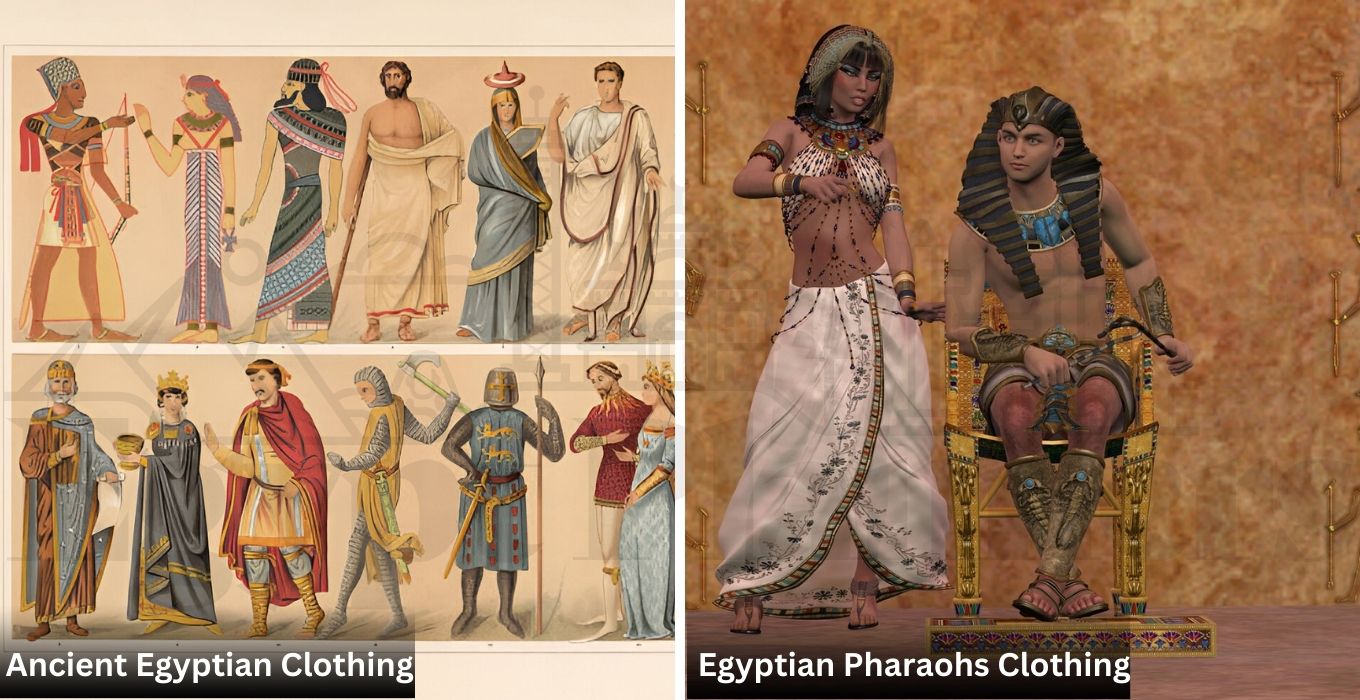
Embark on a captivating exploration of ancient Egypt, a civilization renowned for its rich history, magnificent monuments, and intriguing culture. As you unravel the mysteries of this ancient land, don’t miss the opportunity to delve into the fascinating world of ancient Egyptian clothing. The attire worn by the ancient Egyptians offers a unique window into their social structure, beliefs, and daily life. From the elaborate garments of the pharaohs to the simple linen clothes of the common people, each piece tells a story.
Ancient Egyptian clothing was primarily made from linen, a lightweight and breathable fabric perfectly suited to the hot desert climate. The Egyptians were skilled weavers, and their linen was renowned for its quality and fineness. The natural color of linen was white, and this was the most common color for clothing. However, they also used dyes to create vibrant hues, such as red, blue, and yellow, to adorn their garments.
A Reflection of Social Status Through Egyptian Clothing Ancient
The type of clothing worn in ancient Egypt often reflected the social status of the individual. The pharaohs, the supreme rulers of Egypt, wore elaborate costumes made from the finest linen and adorned with gold, jewels, and intricate embroidery. Their headdresses, such as the iconic nemes, were symbols of their power and divinity.
Ancient Egyptian Clothes for Every Class
The clothing of the elite and the common people differed significantly. While the wealthy could afford luxurious fabrics and elaborate designs, the common people wore simpler garments made from coarser linen. Men typically wore a kilt-like garment called a shenti, while women wore long, flowing dresses.
Ancient Egyptian Clothing Male: Practical and Functional
The shenti, the most common garment for men, was a rectangular piece of linen wrapped around the waist and tied with a belt. The length of the shenti varied according to the social status of the wearer. The pharaohs and nobles wore long shenti that reached their ankles, while the common people wore shorter ones that reached their knees.
Ancient Egyptian Women’s Clothing: Elegant and Graceful
Women’s clothing in ancient Egypt was typically long and flowing, made from linen and often adorned with pleats or decorative elements. The most common garment was a long, fitted dress that reached the ankles, held up by straps over the shoulders. Wealthy women might also wear a sheer tunic over their dresses, adding a touch of elegance.
Interesting Facts About Clothing & kalasiris Ancient Egypt
The ancient Egyptians were also fond of jewelry and accessories. Both men and women wore necklaces, bracelets, earrings, and rings made from various materials, including gold, silver, and precious stones. Amulets, believed to provide protection and good luck, were also popular.
Exploring the clothing of ancient Egypt offers a fascinating glimpse into the lives of the people who lived in this remarkable civilization. This article reveals their social hierarchy, their sense of aesthetics, and their practical adaptations to the environment. As you delve into the world of ancient Egyptian fashion, you’ll gain a deeper appreciation for the rich cultural heritage of this ancient land.
Daily Life in Ancient Egypt
Explore the fascinating world of ancient Egypt. Archaeology brings the past to life. The village of Deir el-Medina, home to workers, shows us the lives of those not in the elite.
Ostraca, or limestone flakes, reveal the gossip and daily lives of skilled workers. These finds give us a peek into the lives of those who built Egypt’s famous monuments.
A strict social hierarchy existed in ancient Egypt. At the top were the king and royal family. Below them were educated professionals, workers, and servants. Scribes, chosen by Thoth, were highly respected for their writing and priestly duties.
|
Social Class |
Description |
|
King and Royal Family |
At the apex of the social pyramid, wielding divine authority and power. |
|
Educated Professionals |
Included scribes, doctors, and military generals, responsible for the administration and defense of the kingdom. |
|
Working-Class Individuals |
Skilled craftsmen, artisans, and laborers who supported the construction of monuments and tombs. |
|
Servants and Farmers |
The foundation of ancient Egyptian society, responsible for agricultural production and domestic tasks. |
The Nile River was crucial for daily life. It was a transportation route and gave land for crops like wheat and barley. Bread, vegetables, and fish were the main foods.
Entertainment in ancient Egypt was varied. People enjoyed hunting, board games, and sports. They also had parties, music, and dancing. Festivals were important, celebrating gods’ birthdays and the Nile’s flooding.
Unravel the captivating details of daily life in ancient Egypt, where the past comes alive through the lens of archaeology. Excavations at the ancient village of Deir el-Medina have provided a unique glimpse into the everyday lives of the non-elite members of this ancient civilization.
The Legacy of Ancient Egyptian Art and Architecture
The ancient Egyptians made a big impact on the world. Their art and architecture are still amazing today. From the pyramids to the hieroglyphics, they left us in awe.
Their art changed over time, showing different styles. From the early days to the later periods, their art shows Egypt’s rich culture. The Nile River helped their civilization grow for over 3,000 years.
Art in ancient Egypt was more than just pretty pictures. It was a way to talk, show beliefs, and remember important people. Tomb art connected the living with the dead. Buildings like temples showed the society’s values.
The legacy of ancient Egyptian art and architecture is amazing. The Pyramids and Sphinx still amaze us. Their art and designs have influenced many cultures worldwide.
“The art of ancient Egypt has endured for thousands of years, captivating audiences and inspiring artists, architects, and scholars alike.”
Exploring ancient Egyptian culture shows us their lasting impact. It reminds us of their incredible civilization and its influence today.
Ancient Egyptian Discoveries and Archaeological Sites
The mysteries of ancient Egypt still excite us all. Archaeologists keep finding new things that tell us about this amazing civilization. They find things like ostraca, tomb paintings, and hieroglyphs. These items help us understand the ancient Egyptians’ beliefs, technology, and traditions.
In 1904, Ernesto Schiaparelli found Nefertari’s tomb (QV66). Émile Brugsch found Seti I’s mummy in 1881. But the biggest find was Tutankhamun’s tomb (KV62) by Howard Carter in 1922. He spent 10 years listing the 5,398 items inside.
There were more finds like a ship found with the Great Pyramid of Khufu in 1954. In 1995, KV5, the biggest tomb in the Valley of the Kings, was fully explored. And in 2000, the sunken city of Thonis-Heracleion was found, revealing Egypt’s ancient sea history.
|
Year |
Discovery |
Discoverer |
|
1904 |
Nefertari’s tomb (QV66) |
Ernesto Schiaparelli |
|
1881 |
Mummy of Seti I |
Émil Brugsch |
|
1922 |
Tutankhamun’s tomb (KV62) |
Howard Carter |
|
1954 |
Ship buried beside the Great Pyramid of Khufu |
Kamal el-Mallakh |
|
1995 |
Largest tomb in the Valley of the Kings, KV5 |
Kent R. Weeks |
|
2000 |
Sunken city of Thonis-Heracleion |
European Institute for Underwater Archaeology |
These are just a few of the amazing ancient Egyptian discoveries. They keep us all fascinated. As we study and protect these archaeological sites, we learn more about this incredible civilization. And we see how it still affects us today.
FAQs: Exploring Ancient Egypt
What are 5 facts about ancient Egypt?
- Geography: Ancient Egypt was centered around the Nile River, which provided fertile land for agriculture.
- Pharaohs: The rulers of ancient Egypt, known as pharaohs, were considered both political leaders and divine figures.
- Pyramids: The Great Pyramid of Giza is one of the Seven Wonders of the Ancient World and served as a tomb for Pharaoh Khufu.
- Hieroglyphics: Ancient Egyptians used a complex writing system called hieroglyphics, which combined logographic and alphabetic elements.
- Religion: Ancient Egyptians practiced polytheism, worshipping a pantheon of gods and goddesses, such as Ra (the sun god) and Osiris (the god of the afterlife).
2. Can you visit ancient Egypt?
Yes, you can visit ancient Egypt today by traveling to modern-day Egypt. Many ancient sites, such as the pyramids, temples, and tombs, are preserved and open to the public, particularly in cities like Cairo and Luxor.
3. What was the best way to travel around ancient Egypt?
The best way to travel around ancient Egypt was primarily by the Nile River. Boats were commonly used for transportation and trade. Land travel was also possible via caravans or on foot, but the river was the most efficient means of moving goods and people.
4. What is the most beautiful place in ancient Egypt?
One of the most beautiful places in ancient Egypt is the Temple of Karnak, located near Luxor. It is an expansive complex of temples and chapels, adorned with impressive hieroglyphics and magnificent statues, reflecting the grandeur of ancient Egyptian architecture.
5. Where to start with Egyptian history?
To start with Egyptian history, you can begin with the Early Dynastic Period, followed by the Old Kingdom, which includes the pyramid-building era. Key events, important pharaohs (like Ramses II), and major accomplishments, such as advances in art, architecture, and writing, can provide a solid foundation for understanding the civilization’s evolution. Books, documentaries, and online resources can also be helpful in exploring this rich history.
Conclusion: Exploring Ancient Egypt
As you finish exploring ancient Egypt, it’s clear this civilization made a big impact. The pyramids, temples, hieroglyphs, and myths still amaze us today. It’s up to us to keep these treasures safe for others to see in the future.
Supporting research helps us learn more about the ancient Egyptians. Keeping their heritage safe is key to understanding them better. Archaeologists and scholars work hard to protect these wonders for us all.
The ancient Egyptians left us a gift that still excites people everywhere. By working to save their culture, we help keep their legacy alive. This way, we ensure their amazing stories and achievements are always remembered.
You can learn more about the history of ancient Egypt through our following article:

